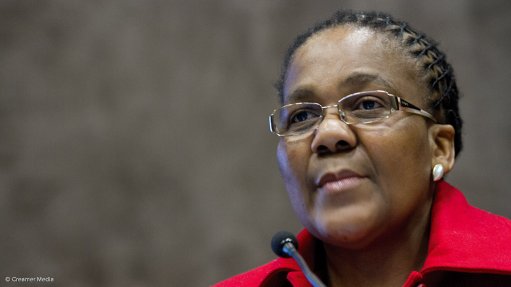
Dipuo Peters
Photo by: Duane Daws
In the 2013/14 financial year, more than R5-billion would be spent in 13 South African cities on planning, building and operating integrated public transport networks, said Transport Minister Dipuo Peters in Pretoria, on Tuesday.
Speaking at the launch of the 2013 October Transport Month, she said Cape Town and Johannesburg had already constructed more than 20 km of dedicated bus rapid transport (BRT) lanes, supported by more than 100 km of feeder and distribution services.
In the 2013/14 financial year, Cape Town and Johannesburg would expand operations on the Rea Vaya and My CiTi services, respectively, to carry up to 100 000 passenger trips a day on each system, noted Peters.
Rea Vaya buses currently transported an average of around 40 000 people to and from work daily, she added.
Peters said BRT systems were catalysts for “urban regeneration, reconnecting isolated nodes and bringing disconnected communities closer to economic opportunities”.
She said the George municipality, in the Western Cape, was a new entrant into the bus “public transport network development enterprise”. George would, however, complete its citywide network at a more modest scale than the networks being constructed in the major metropolitan areas.
Buffalo City, Ekurhuleni, Mangaung, Msunduzi and Polokwane were all set to complete their public transport network development planning and service contract designs during the course of the 2013/14 financial year, starting with network development in the 2014/15 financial year, said Peters.
MOLOTO CORRIDOR
The target date for the completion of the feasibility study on a transport solution for the Moloto Corridor was set for March 10 next year, said Peters.
The Moloto Corridor stretched from Mpumalanga into the Tshwane metro. Around 35 000 commuters were transported to Tshwane in the mornings, using 536 subsidised buses, with the same number travelling the roughly 100 km back to Mpumalanga in the evening.
“Commuters spend long hours in transit, with some, in extreme cases, spending up to seven hours per day on buses,” said Peters.
Exacerbating this situation was the lack of economic development and job opportunities along the corridor.
“This is considered to be an unsustainable situation. The department [of Transport] has conducted a feasibility study into options to mitigate the situation,” said Peters.
Rail was one option being considered. The Moloto Corridor project had been registered with Treasury as a public-private partnership project. The project also fell under Strategic Integrated Project 1 being overseen by the Presidential Infrastructure Coordinating Commission - unlocking the Northern Mineral Belt.